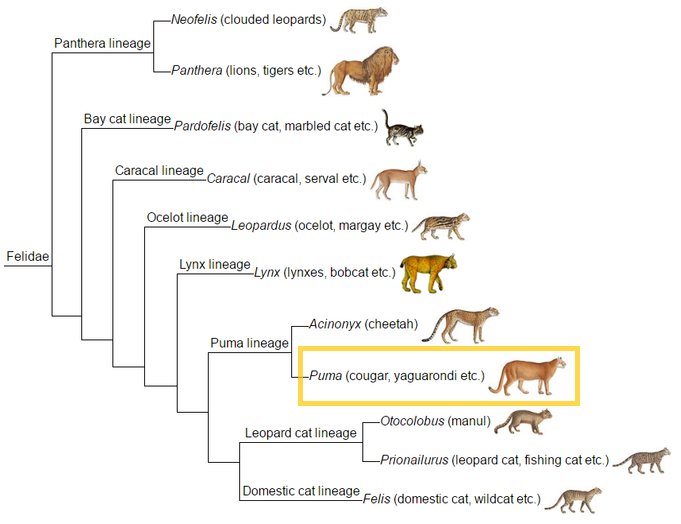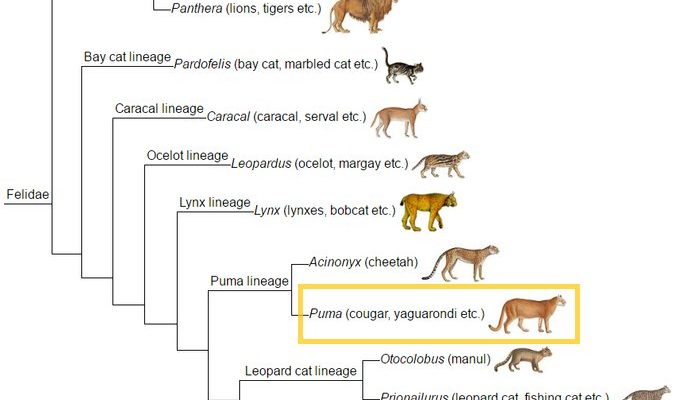
The evolutionary history of the cougar is a tale that stretches back millions of years. From its earliest ancestors to the majestic cats we see today, each chapter is filled with interesting twists. So grab your coffee, and let’s take a closer look at how this remarkable feline evolved!
Early Ancestors
The story of the cougar begins with its ancient relatives. The earliest members of the *Felidae* family, which includes all cats, appeared around 25 million years ago. These primitive cats were small and lived in diverse habitats. They had to compete with other predators and adapt to changing environments. As time passed, the lineage that would lead to modern cougars branched off.
You might be curious about the specific link between cougars and their ancestors. The genus *Puma*, which encompasses modern cougars and their close relatives, emerged around 10 million years ago. This was a critical development in cat evolution. During this time, they began adapting to habitats that varied from grasslands to forests, positioning themselves as versatile hunters.
These early cats were larger and had different adaptations compared to today’s cougars. For instance, they had more robust builds, which helped them tackle larger prey. Isn’t it fascinating to think how much they had to adjust to their environment, just like modern cougars do today?
The Great Migration
About 2 million years ago, during the Pleistocene epoch, many animals underwent significant migrations, including the ancestors of cougars. This period was marked by dramatic climate changes and the expansion of ice sheets. Cougars migrated across North America, adapting to new terrains and ecosystems as they went.
This migration wasn’t just a stroll in the park; it involved a struggle for survival. As they traversed vast distances, these cougars learned to hunt a variety of prey. Their diet expanded from small mammals to larger animals such as deer. This adaptability was crucial—it allowed them to thrive in different habitats, from coastal regions to mountainous areas.
It’s remarkable to think about the challenges these early cougars faced. Each step they took was a testament to resilience. They were not just surviving; they were evolving into the efficient hunters we recognize today.
Survival Through Climate Changes
As the Pleistocene epoch gave way to warmer temperatures, cougars faced new challenges. The extinction of many large mammals, such as mammoths and saber-toothed cats, forced them to adapt once again. Some species of cougars became extinct, while others managed to survive and find their niche in the ecosystem.
The modern cougar, which we see today, can trace its lineage back to these survivors. They adapted by refining their hunting techniques, becoming stealthier and more proficient. Their ability to thrive in different environments has allowed them to occupy a wide range of habitats, from the forests of Canada to the deserts of the American Southwest.
Cougars have developed a unique style of hunting that sets them apart. They are ambush predators, relying on stealth rather than speed. Picture a well-camouflaged cat, lying low among the underbrush, waiting for the perfect moment to strike. That’s the essence of a cougar’s hunting strategy.
Cougars in Historical Context
As humans began to expand their territories, cougars and humans crossed paths more frequently. In many Native American cultures, cougars were revered as powerful symbols of strength and agility. They were often seen as protectors and were woven into folklore and spiritual beliefs.
However, this growing interaction also led to conflict. As settlers moved westward, cougars were hunted and trapped, leading to a significant decline in their populations. Their once vast territories were gradually reduced due to urban development and agricultural expansion. It’s a poignant reminder of how human actions can impact wildlife.
Despite these challenges, cougars have shown remarkable resilience. They have bounced back in many areas where they were once driven out. This tenacity speaks to their adaptability, much like their ancestors who survived countless changes in their environment.
Modern Cougars and Conservation Efforts
Today, cougars are classified as a species of “Least Concern” by conservation organizations. However, this doesn’t mean they’re out of the woods. Their populations are still vulnerable in certain regions, mainly due to habitat loss and fragmentation. Conservation efforts are essential to ensure their survival.
Organizations and wildlife agencies focus on restoring habitats and connecting areas where cougars can roam freely. These initiatives are vital because cougars need large territories to thrive. Just imagine a wandering cat exploring its habitat without the barriers that modern human developments often impose!
Moreover, education plays a significant role in cougar conservation. Communities are becoming more aware of the importance of coexisting with wildlife. By understanding cougar behavior and ecology, people can help mitigate conflicts and promote coexistence. After all, a healthy ecosystem benefits us all!
The Future of Cougars
The future of cougars is a mixed bag of challenges and hope. While many regions are seeing a resurgence of these magnificent cats, ongoing threats like climate change and urbanization persist. Cougars may need to adapt once more, navigating a world that continues to change.
Research into their behavior is crucial. Scientists study how cougars are responding to changing climates, prey availability, and human encroachment. This knowledge is invaluable for developing effective conservation strategies.
It’s also essential to foster a sense of appreciation for these apex predators. By showcasing their natural beauty and ecological importance, more people may become advocates for their protection. Cougars aren’t just another animal on the planet; they play a vital role in maintaining the balance of ecosystems.
The evolutionary history of the cougar is a captivating saga that reflects the resilience and adaptability of a species that has survived through millions of years. From their ancient ancestors to the modern cougars roaming our wilderness, their tale is one of survival against the odds.
Understanding this history is more than just a walk down memory lane; it’s about recognizing the importance of preserving these incredible animals for future generations. As we navigate the challenges posed by modern living alongside wildlife, we can learn valuable lessons from cougars. They remind us of the delicate balance between nature and humanity, urging us to protect not only their future but the future of our shared ecosystems. So next time you think of cougars, remember their journey—it’s a story worth sharing.

